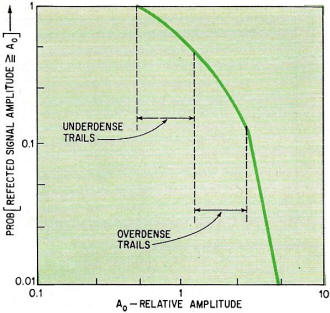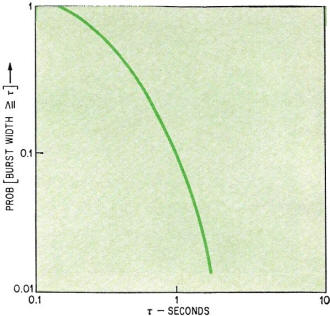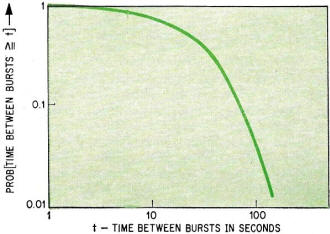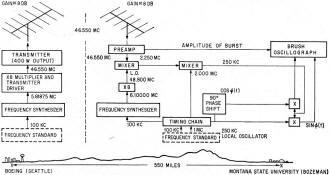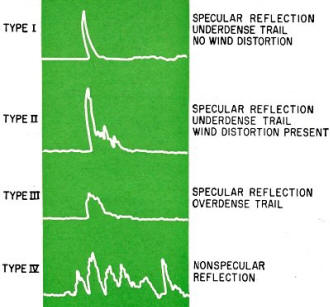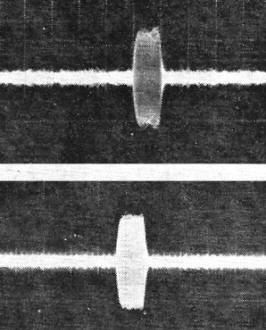Messages by Meteor
|
|
Meteor scatter (aka meteor burst) communications is today largely the domain of amateur radio operators in their ongoing attempts to set records for making long distance (DX) contacts with a minimum amount of transmit power. When this article was written by U. California's Victor Latorre, transcontinental fiber optic cables did not interconnect the world with high speed, phase stable media that meets the exacting needs of precise time synchronization. Radio astronomy, quantum physics experiments, and even stock market trading (see Arbitrage via Microwaves) depends on microsecond or finer timing. Mr. Latorre explains in this 1965 issue of Electronics magazine how meteor scatter communications' unique phase-stable characteristic is used to send synchronization signals between scientific and navigation facilities. Of course meteor scatter has the severe disadvantages of being unpredictable in time and place, short-lived, and varying in levels of ionization of the upper atmosphere with attendant frequency and bandwidth accommodation. That very unpredictability, however, in opportunity was exploited by the military to send secure, encrypted messages across the globe. Messages by Meteor
By Victor R. Latorre, University of California, Davis With a meteor trail and simple, inexpensive equipment, very high frequency signals can be transmitted over the horizon to a point as far distant as 1,200 miles. The technique, known as the meteor scatter mode, cannot be used to transmit real-time data because the meteor scatter mode is not a continuous medium. The meteor trails that reflect signals occur at discrete intervals of time, rather than continuously, and would not be suitable, for example, in a command data link where real-time data must be transmitted without delay. However, for those situations where delays between data transmission can be tolerated, a meteor scatter system is far less expensive than tropospheric and ionospheric scatter systems. One of the advantages of the meteor scatter mode is excellent phase stability, which can be applied in a time distribution system that could synchronize clocks at distant locations within about 200 nanoseconds. Such a system would be simple and yet have five times the accuracy of the best currently available time distribution system. Statistical distribution of signal amplitudes reflected from meteor trails, as measured on the experimental meteor scatter link between Seattle and Bozeman, Mont. Chart is a plot of the measured probability of reflected signal amplitudes that will be greater than some arbitrary reference. Underdense bursts are characterized by that part of the distribution curve whose slope varies from 0 to -1; overdense bursts are characterized by slope from -1 to -4. The curve becomes discontinuous falling off to a constant slope = -5.7, which indicates additional ionospheric scattering, and multiple trails in the burst. The meteor scatter mode depends upon signal reflection from meteor trails, a phenomenon that has been fairly well analyzed in the past few years. It is interesting that early investigators attributed the enhancement of vhf signals beyond the horizon to holes created in the ionosphere by meteor particles, although it is now known that the trail created by the particles causes the reflections. In this article the scattering mechanism itself is analyzed, and its important features are discussed for the system designer. The basic considerations are evaluated for a meteor burst system design and the results are presented from an experimental system that has been in operation for the past two years between Montana State University, in Bozeman, and the Boeing Co., in Seattle. Shower and Sporadic Meteors To analyze the properties of the meteor burst propagation medium, a logical starting point is the meteor particle itself, since it is responsible for the existence of the scattering surface or volume of the medium. Individual meteor particles vary in radius from about 40 microns to about 8 centimeters, and their mass varies from 10-7 gram to about a kilogram. The velocity of the particles varies between 11.3 and 72 kilometers per second. Millions of meteor particles enter the earth's atmosphere each day. Normally, they are placed into two distinct categories - shower meteors, which are predictable and occasionally quite spectacular, and sporadic meteors. Shower meteors are concentrated in streams of well-defined orbits about the sun; they travel in an ecliptic plane in much the same direction as the earth moves about the sun. But only a small percentage of the total number of meteors are shower meteors. Since the sporadic meteors occur much more frequently, they are far more important for radio communications. Both their location and frequency of occurrence seem to be random. Meteor Trails The actual mechanism by which the trail of the meteor is formed is not well defined, but a reasonable explanation of it can be offered. A fast-moving particle approaching the earth enters a region in which there is a relatively rapid change in atmospheric density. This region extends from about 80 to 120 kilometers above the earth's surface and is characterized by a diffusion constant that varies from about 1 to 140 square meters per second. (Diffusion constant, which is a function of the air density, describes the rate at which the electrons in the meteor trail tend to disperse.) Statistical distribution of burst durations as measured on the Seattle-Bozeman link. Curve is a plot of the measured probability of meteor bursts occurring whose duration is greater than an arbitrary duration. Above this region, a meteor trail can't form because the air is too thin; below this region, a meteor trail can't exist because the meteor is pretty much burned up due to the heavy air density. The collision between the high-velocity particle and the air molecules in this region produces ionization, heat, and light. Because the mass of the particle is quite large relative to the air molecule, the velocity of the particle remains fairly constant until it vaporizes. When the particle vaporizes it produces a thin meteor trail that can be as long as 50 kilometers and that varies in radius between 0.5 and 4.35 meters. Some investigators say that the trail has an outer sheath, which is indicated by the presence of intense ultraviolet light. This sheath has a different electron density from that of the rest of the trail. At frequencies higher than about 50 megacycles, the sheath causes some reflection in addition to that caused by the trail itself; at lower frequencies, the sheath is essentially transparent to incident electromagnetic radiation. Most investigators have categorized the meteor trails into four groups: underdense, underdense-distorted, overdense, and overdense-distorted trails. The first two categories are characteristic of low-density trails (less than 1014 electrons/meter), whose electrons act as individual in-phase scatterers, each one affecting the signal equally. The underdense and underdense-distorted trails are also distinguished from the others because signals reflected from them have a fast rise time. The difference between the underdense and under dense-distorted trails is the irregular shape of the latter, which is caused by wind shear. Because of its irregular shape, the underdense-distorted trail causes modulations during the decay interval of the reflected signals. Overdense trails have a higher concentration of electrons (i.e., greater than 1014 electrons/ meter). Signals reflected from these trails are characterized by a relatively slow rise time and a fairly constant amplitude. Because it's more dense, the overdense-distorted trail is broken into several distinct blobs, or segments, when wind shear is sufficient. Thus, the amplitude of a signal reflected from such a trail will fluctuate somewhat. For the case where long signal wavelengths (low frequencies) are to be considered, the trail is assumed to be a long, thin cylinder, since the wavelength is longer than the radius of the trail, and the duration of the trail is much greater than its formation time. For short wavelengths, however, the wavelength is equal to or smaller than the radius of the trail. Therefore, the trail is essentially always in a transient condition, and must be considered as having the shape of a paraboloid. The pertinent mathematical expressions for the various burst modes will not be derived here. Instead, the physical phenomena will be explained qualitatively. Physical Considerations Perhaps the most important point to realize is that the received power in a meteor burst system is a direct function of the wavelength raised to the nth power, where n varies between 3 and 6, depending on many factors, including frequency and the shape of the trail. Because of this, meteor scatter systems operate in the lower portions of the vhf frequency band, where the wavelengths are longer. Research is presently under way at the University of California to determine experimentally the practical upper frequency limit. Another consideration is that reflections from the nondistorted underdense and overdense trails are specular. That is, the angle of incidence at which the signals arrive at the trail is equal to the angle of reflection. This implies that meteor scatter links are somewhat directional in nature, and therefore can provide some degree of privacy from unauthorized or unintended interception of messages. Since the meteor burst channel is not continuous, it is necessary to describe it statistically. In general, the statistical fluctuations are divided into two distinct parts - short-term and long-term variations. Representative distributions obtained last year on the meteor burst communications link between Seattle and Bozeman are shown in charts. The chart on the preceding page shows the measured statistical distribution of reflected signal amplitudes greater than any given arbitrary reflected amplitude. From this chart, it can be seen that all of the reflected signals will have an amplitude greater than approximately 0.6 A0 while only about 10% will be greater than about 3.0 A0, where A0 is an arbitrary reference level. The chart at the top of this page shows the measured statistical distribution of the duration of meteor bursts as a function of time. Of the burst durations measured, 100% lasted more than about 0.15 seconds, while only 2% lasted for as long as 1.5 seconds. Burst durations theoretically have a Poisson distribution, which characterizes purely random events. However, the measured curve is slightly different from the expected distribution for short burst durations; this is due primarily to the presence of distorted overdense bursts. The measured statistical distribution of time between bursts is shown in the other chart on this page. Here, it can be seen that the minimum time between bursts was one second, and that only about 5% of the intervals between bursts were greater than 100 seconds. Although meteor bursts occur randomly, the measured data again deviates from theory, due to distorted overdense bursts. Signal Variations The majority of meteor burst channels operate in the vhf range of the spectrum (30 to 300 megacycles), where signals are subject to absorption in the D-layer in the same manner as signals that depend on normal ionospheric reflections. At night, this absorption is generally negligible for vhf frequencies. At about midday, however, signals in this frequency range may suffer up to 10 decibels of attenuation. And absorption increases during ionospheric disturbances, such as solar flares or auroral activity caused by magnetic storms, affecting meteor scatter signals up to 100 megacycles. In addition to susceptibility to absorption in the ionosphere, other variations in signal can be caused by: geographical location of both the transmitter and receiver; the actual path length between the transmitter, the meteor trail and the receiver; and the antenna patterns employed. The optimum antenna pattern for the burst channel appears to be a split-beam pattern. Research is in progress, however, on self-adaptive antennas whose patterns can be varied in accordance with diurnal variations in the ionosphere. Other types of diurnal and seasonal variations must also be considered. For example, there are diurnal variations in meteor arrival rate (the maximum occur at around sunrise and the minimum at sunset), meteor velocity, and effective radiants (position in the sky of the meteor trails); all of which affect system performance. The major seasonal variation seems to be in the meteor arrival rate. The maximum number of bursts occur in August; the minimum in February. Typical Meteor Scatter System In a meteor scatter communications network, one station is a master, or base, station and the others are slave, or remote, stations. The most obvious requirement of the typical meteor scatter system is some method to inform a slave station that a usable meteor trail is available. A slave station will remain silent until it receives an individual and distinct interrogation, or pilot tone, from the master station. When the pilot tone exceeds a preset threshold, the slave station transmits any information it may have at that time. When the pilot tone falls below the threshold, this signifies that the trail has decayed, and transmission ceases. In a system with two or more stations capable of transmitting information to each other, each station transmits a pilot tone, which, when received by another, initi-ates information transmission. There are several possible methods for alerting the system to the presence of meteors, but all have the same basic purpose - to inform other stations in the network that satisfactory communication is possible. This closed-loop feature is characteristic of all meteor scatter systems. The preceding discussion implies the existence of another characteristic peculiar to meteor burst systems; namely, the ability to make decisions. Meteor scatter systems are limited by the kind of information that can be transferred. In the case of data transmission, for example, only non-real-time data can be transmitted, since the channel is not continuously available. Thus, this propagation mode would be impractical for a command-control system because it sometimes takes as long as 30 minutes for a suitable meteor trail to form. Such a long delay obviously could be most disastrous for the quick-response requirements of modern military systems. Experimental System Although the meteor burst system between the Boeing Co. in Seattle and the Electronics Research Laboratory at Montana State University in Bozeman is experimental, a discussion of it nevertheless illustrates the techniques and the practical problems encountered with operational systems. The Boeing-ERL meteor scatter link, which was established in the early part of 1960, spans a linear distance of some 550 miles. Most of the initial effort with this channel was devoted to determining the basic propagation path loss, the channel's duty cycle (ratio of available transmit time to dead time) as a function of time of day and as a function of receiver threshold, the cumulative burstwidth distributions, and the channel's reciprocity conditions (offset between the master and slave stations' transmit frequencies). Subsequent tests were performed using frequency modulation and correlation detection techniques. Phase Stability and Time Synchronization Waveform envelopes of signals received from the various types of meteor trails are shown in recordings presented at the Navy Research and Development Clinic, Bozeman, Mont., July, 1964. In 1962, a series of experiments produced statistical information concerning the phase stability of signals reflected from the meteor trails. The results of these phase stability tests were very encouraging and formed the basis for the design of an experimental instantaneous time-synchronization system between Bozeman and Seattle. In such a system, a pulse is transmitted from one site to the other at an accurately known time according to the clock. The operator at the receiving station is informed via telephone as to the precise time the pulse will be transmitted, and he sets his clock accordingly. The error between the two clocks is only that caused by the delay time in the equipment, since the delay time due to the data-transmission path can be measured and taken into consideration when the clocks are synchronized. Even though it was rather crude, initially, the system was still capable of synchronizing clocks at the two locations within 15 microseconds. A block diagram of the equipment used in the phase stability experiments is shown below. At the Seattle terminal, a 46.548-megacycle signal was transmitted. When a suitable meteor trail occurred, the signal was received at Bozeman. By examining the waveform envelope of the received signal, it was possible to identify the specific propagation mechanism; that is, whether the propagation was indeed by meteor (and the specific type of meteor trail, or whether it was by sporadic-E, a phenomenon characterized by occasional lowering of the E-layer of the ionosphere, or by other ionospheric effects. Only those signals reflected from meteor trails were used in the phase stability analysis. In addition to the envelope of the demodulated signal, the quadrature signals, sin 4Φ(t) and cos 4Φ(t), which describe the phase character-istics of the signal, were recorded on a multiple channel recorder. The test data was analyzed on an IBM 1620 computer. From an analysis of the phase information for both the underdense and overdense trails, it was determined that phase shift in meteor burst propagation is very nearly a linear function of time, and is so small that a time distribution system using the meteor scatter mode would be capable of operating with timing errors as small as 20 nanoseconds. This becomes clear from the data for a typical trail of 300 milliseconds duration, during which the phase shift varied at a rate of 20 radians per second. This results in a total change in time delay of about 20 nanoseconds, which is the ultimate timing potential of the medium. It is interesting to observe that the degree of expected accuracy using this mode is considerably greater than that obtained with conventional high-frequency systems, such as the National Bureau of Standards' WWV time and frequency distribution system, which transmits standard frequencies at 10 and 20 Mc, and pulses at accurately measured intervals according to the clock. But since the WWV system relies on ionospheric reflection of h-f signals, where it is difficult to precisely determine the path length, it is able to provide timing information within only a millisecond. Meteor scatter time-synchronization systems are potentially equal to or greater than the best currently available system - the loran-C, which is capable of achieving time synchronization to within about a microsecond. Correlation Techniques Pulses received via meteor scatter over the Bozeman-Seattle link. Top pulse was reflected by an underdense burst, and pulse at bottom by an overdense burst. Phase of received pulses indicates relatively stable path lengths. The application of correlation techniques to the detection of signals transmitted via the meteor scatter mode is another important tool for the communications system designer. The results of an experiment establish that the usable duration of meteor bursts can be extended with correlation detection techniques and a delay line matched filter. Besides effectively increasing the signal-to-noise ratio and increasing usable burst time, correlation techniques may be applied in systems that require protection from intentional jamming or from unwanted interception of messages. Bibliography G.W. Pichard, "A Note on the Relation of Meteor Showers and Radio Reception," Proc. IRE, Vol. 19, No.7, July, 1931. Von R. Eschleman, "The Mechanism of Radio Reflections for Meteoric Ionization," Tech. Report No. 49, Electronics Research Laboratory, Stanford University, July 15, 1952. D.M. Reyonds, "Antennas for Meteor-Burst Communication Systems," Tech. Report No.2, Electronics Research Laboratory, Montana State University, January, 1959. J.D. Belenski, "Meteor Burst Communication Research Program," D2-20788, The Boeing Co., Seattle, Wash. J.D. Belenski, "The Application of Correlation Techniques to Meteor Burst Communications," 1962 IRE Wescon Proceedings. D.K. Weaver, P.C. Edwards, A.E. Bradley, and D.N. March, "Final Report, Meteor Burst Time Synchronization Experiments," ERL Tech. Report, Montana State University, August, 1963. George Sugar, "Radio Propagation by Reflection from Meteor Trails," Proc. of IEEE, Vol. 52, No.2, pp. 116-136, February, 1964. V.R. Latorre and G.L. Johnson, "Time Synchronization Techniques," IEEE International Convention Proceedings, March, 1964. Hewlett-Packard Co. Application Note No. 52, "Frequency and Time Standards," Hewlett-Packard Co., Palo Alto, Calif., 1962. V.R. Latorre, "The Phase Stability of uhf Signals Reflected From Meteor Trails," IEEE Transactions on Antennas and Propagation, July, 1965. The author Victor R. Latorre is an assistant professor at the University of California, Davis. His current research project involves remotely measuring the temperature changes in a rat's brain.
Posted October 24, 2023 |
|

 Meteor burst communications systems transmit
secure data over the horizon; excellent phase stability provides time synchronization
with only 200-nanosecond error.
Meteor burst communications systems transmit
secure data over the horizon; excellent phase stability provides time synchronization
with only 200-nanosecond error. 